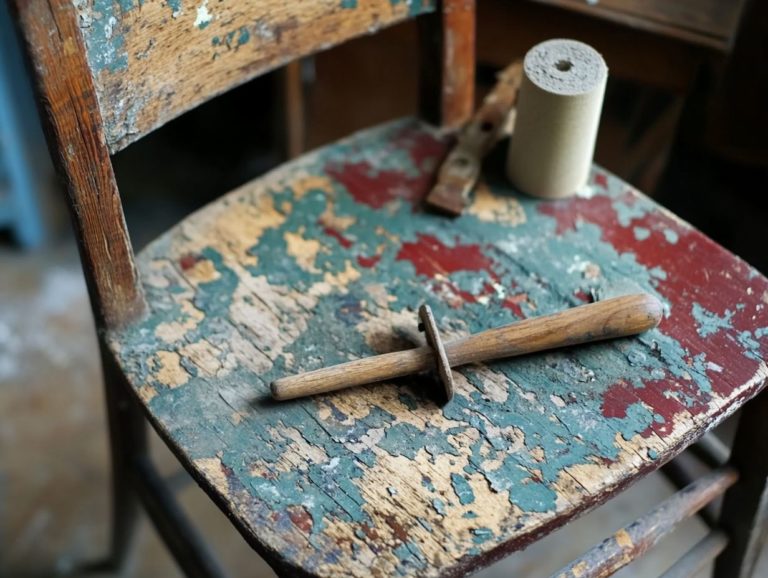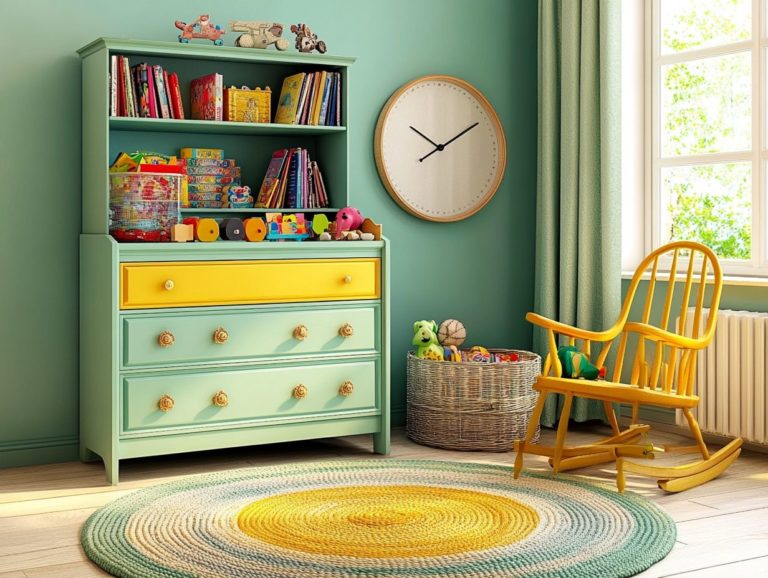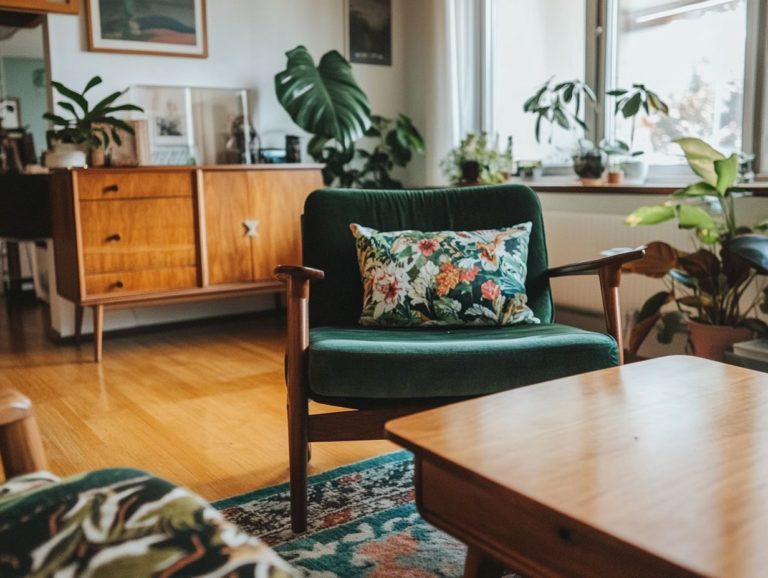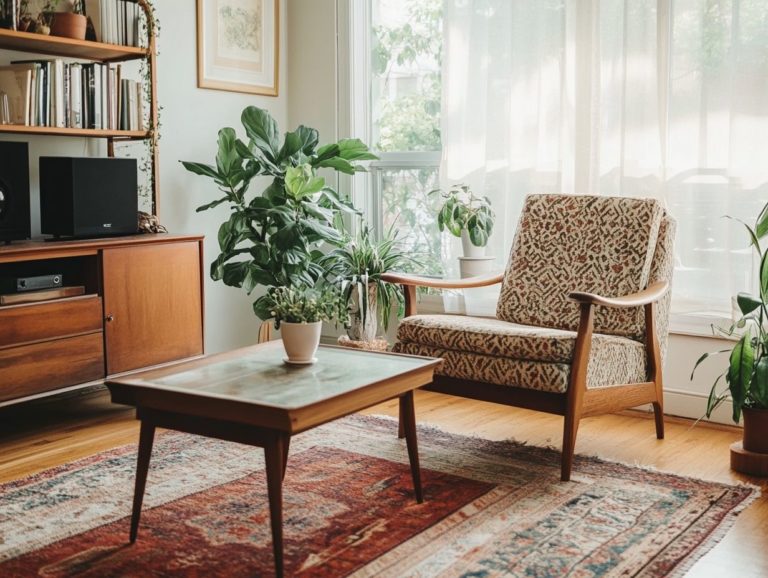Vintage Furniture: How to Spot Reproductions
Vintage furniture possesses a timeless charm that captivates collectors and enthusiasts alike.
In this exploration, you ll uncover the nuances of identifying authentic vintage pieces, including essential characteristics and markings. You will also learn about common reproduction techniques that can deceive even the most discerning eye.
You ll gain valuable tips to ensure your investments are in genuine items and discover best practices for buying and selling vintage furniture. This knowledge will equip you to navigate this rewarding market with confidence.
Get ready to discover the exquisite beauty of vintage furniture!
Contents
- Key Takeaways:
- Defining Vintage Furniture and Its Appeal
- Identifying Authentic Vintage Furniture
- Common Reproduction Techniques
- Tips for Avoiding Reproductions
- Buying and Selling Vintage Furniture
- Common Questions About Vintage Furniture
- What exactly is vintage furniture and how is it different from antique furniture?
- What are reproductions and how can I tell them apart from authentic vintage furniture?
- Are there any specific eras or styles of vintage furniture that are commonly reproduced?
- What are some red flags to look out for when trying to spot reproductions?
- Is it okay to buy reproductions or should I only focus on authentic vintage furniture?
- What are some tips for properly caring for and maintaining vintage furniture?
Key Takeaways:

- Beware of furniture labeled as “vintage” or “antique” without proper documentation or characteristics. Reproductions are common and can deceive buyers.
- Authentic vintage furniture is often marked with specific characteristics such as patina, hardware, and joinery. Look for these details to ensure authenticity.
- To avoid purchasing reproductions, research the history and production methods of the specific furniture piece. Consult with experts or utilize online resources to verify authenticity.
Defining Vintage Furniture and Its Appeal
Vintage furniture, with its distinctive charm and exquisite craftsmanship, provides an aesthetic appeal that goes beyond mere functionality. It reveals the artistry of bygone eras.
Crafted often from natural materials like mahogany, oak, and walnut, these pieces serve more than just a purpose; they narrate stories steeped in historical significance.
The true allure of vintage furniture lies in its power to infuse warmth and character into any space. This makes it a coveted choice for collectors and homeowners alike who wish to incorporate a touch of nostalgia into their decor.
Identifying Authentic Vintage Furniture
Identifying authentic vintage furniture demands a discerning eye. Pay close attention to details such as makers’ marks and furniture construction techniques that set these treasures apart from modern reproductions.
An authentic piece often reveals distinctive signs of wear. Each scratch and imperfection tells a story of its age and history, which is vital in the appraisal process.
Understanding the furniture construction methods like the art of dovetailing (a woodworking joint that interlocks two pieces of wood, showcasing exceptional craftsmanship) can provide invaluable insight into the authenticity of a vintage item.
Key Characteristics and Markings
Key characteristics and markings are vital when identifying authentic vintage furniture. Look for makers’ marks that reveal the origin and craftsmanship of each piece.
Signs of wear, like uneven surfaces and minor scratches, hint at the item’s age and add to its historical authenticity. They also display the importance of furniture craftsmanship.
Traditional woodworking techniques, such as dovetailing, provide valuable insights into the furniture’s construction quality and overall value.
Understanding these features enhances your appreciation for the artistry involved and aids in your evaluation process. For example, well-executed dovetail joints signal superior craftsmanship and can significantly raise the market value of a vintage item.
As a collector, you must be vigilant when analyzing these signs. Damaged or poorly repaired areas can undermine authenticity, while original features evidenced by distinctive makers’ marks and natural wear can boost both sentimental and monetary worth, enhancing the overall quality of wooden furniture.
In essence, the journey of identifying vintage furniture combines a passion for history with the astuteness of market insights.
Common Reproduction Techniques
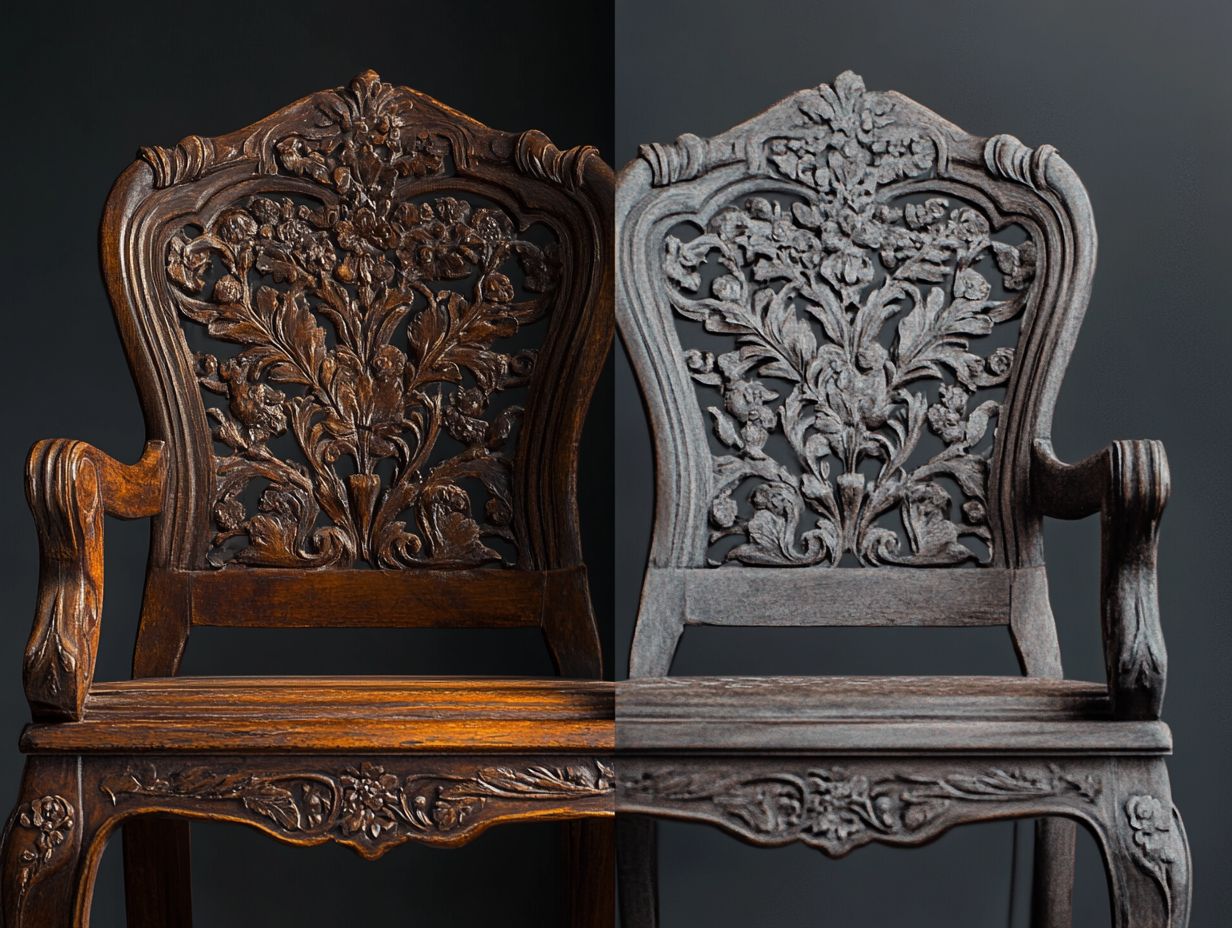
Understanding common reproduction techniques in furniture making is essential, particularly in a market overflowing with faux pieces that replicate the charm of genuine vintage items.
These techniques frequently employ modern materials and manufacturing methods, which can easily mislead even the most discerning collectors.
By recognizing the nuances in craftsmanship and woodworking techniques between reproduction furniture and authentic antiques, including antique furniture, you enable yourself to make informed buying or selling decisions.
How to Spot Reproductions
Spotting reproductions requires a discerning eye. You ll need to examine various indicators, such as the condition of the wood.
Look for signs of wear that distinguish genuine vintage furniture from its imitations. Reproduction pieces often fall short in the depth of character and uneven surfaces that authentic items develop over time.
This makes it essential for you to scrutinize every detail during the appraisal process. Understanding these differences will enable you to avoid costly mistakes and enrich your collection with genuine antiques.
Pay close attention to craftsmanship; original furniture usually showcases intricate joinery, such as dovetail joints. In contrast, reproductions often rely on simpler, mass-produced techniques.
It’s also wise to look for inconsistencies in finishes. Authentic pieces develop a unique patina that reproductions typically lack.
Consulting case studies, particularly those from antique appraisers, can provide valuable insights. Gaining knowledge about grain patterns and familiarizing yourself with typical imperfections will significantly enhance your evaluation skills.
By merging these practical insights with expert opinions, you can cultivate a keen eye for distinguishing between the old and the new. This ensures that your investments in cherished pieces are both wise and rewarding.
Tips for Avoiding Reproductions
Dive into the vintage furniture market with excitement to find authentic antiques that truly captivate! Navigating this landscape demands a blend of thorough research and a keen eye for detail.
Collaborating with reputable antique dealers can offer invaluable insights into restoration techniques. These techniques enhance a piece s historical authenticity rather than mask it.
Educating yourself about the hallmarks of quality craftsmanship is crucial in avoiding the pitfalls of faux items.
How to Ensure Authenticity
Ensuring the authenticity of vintage furniture requires a thoughtful approach. Start by consulting with experts at antique shops and engaging in thorough appraisal processes.
Key to this endeavor is validating historical authenticity through documentation, such as provenance (the history of ownership) and maker’s marks. This can significantly enhance both the item’s value and its credibility in the market.
Familiarizing yourself with the nuances of different furniture construction techniques will also help distinguish genuine pieces from reproductions.
Antique shops are often treasure troves of knowledge. Staff members are ready to provide insights that you might not uncover online.
For instance, you might hear a seasoned shop owner recounting an extraordinary story about how a hidden label completely transformed the value of an otherwise ordinary chair.
Obtaining a professional appraisal can further illuminate intricate details that signify age and craftsmanship, enabling you to make more informed purchasing decisions.
Collectors frequently emphasize the importance of these authenticating steps. They note that they not only safeguard investments but also deepen one s appreciation for the artistry behind each piece.
Buying and Selling Vintage Furniture

Engaging in the buying and selling of vintage furniture requires a keen strategy that blends market savvy with a true passion for craftsmanship. It s crucial for you to explore a variety of avenues, including auction opportunities, antique dealers, and private sellers.
By immersing yourself in market trends and understanding the values of different woods and styles, you can greatly enhance your buying experience and boost your chances of a profitable sale.
Whether you re an avid collector or simply seeking to imbue your home with unique character, navigating this landscape can offer both rewarding experiences and intriguing challenges.
Start your journey in the vintage furniture world today! Discover unique pieces that tell a story and enrich your home.
Best Practices and Resources
Implementing best practices when buying or selling vintage furniture can significantly elevate your experience. This ensures that both you and the other party are pleased with the transaction.
Utilizing resources like reputable antique shops, online furniture appraisal platforms, and expert consultations enables you to make informed decisions. You can truly appreciate the vintage charm each piece holds.
Staying educated on market trends and evolving styles will guide you through this specialized industry.
Networking with experienced collectors and participating in vintage fairs can enrich your understanding of the market. Frequenting industry blogs, attending workshops, and joining dedicated forums will help you share valuable knowledge.
By fostering a culture of continuous learning, you can better assess the real and valuable vintage items. This ultimately sharpens your negotiation skills and outcomes.
Dive into these practices! They cultivate a deeper appreciation for vintage furniture and help you build lasting relationships within the community. This paves the way for future opportunities.
Common Questions About Vintage Furniture
What exactly is vintage furniture and how is it different from antique furniture?
Vintage furniture typically refers to pieces that are between 20-100 years old. These pieces have a certain style that represents a particular era. Antique furniture, on the other hand, is usually more than 100 years old and holds more historical or artistic value.
What are reproductions and how can I tell them apart from authentic vintage furniture?

Reproductions are newly made pieces that imitate the style of vintage furniture. To spot them, look for signs of machine-made parts and perfect finishes. A lack of natural wear and tear can also indicate a reproduction. Check for labels or markings that indicate the piece is a reproduction.
Are there any specific eras or styles of vintage furniture that are commonly reproduced?
Yes, mid-century modern, Art Deco, and Victorian styles are often the most reproduced. These styles are highly sought after and can be easily replicated, making it important to be extra vigilant when shopping for them.
What are some red flags to look out for when trying to spot reproductions?
One major red flag is if the price seems too good to be true. High-quality vintage furniture can be quite expensive, so if a piece is sold at a significantly lower price, it could be a reproduction. Be wary of pieces that look too new or have overly perfect finishes.
Is it okay to buy reproductions or should I only focus on authentic vintage furniture?
This depends on your personal preferences and budget. Some people prefer authentic vintage pieces, while others are content with reproductions. Just be aware that reproductions may not hold the same value or quality as authentic vintage furniture.
What are some tips for properly caring for and maintaining vintage furniture?
To keep your vintage furniture in good condition, avoid harsh cleaning products. Instead, opt for gentle methods like wiping with a soft cloth and using a mild soap and water solution. Keep the furniture out of direct sunlight and away from extreme temperatures to prevent damage.

